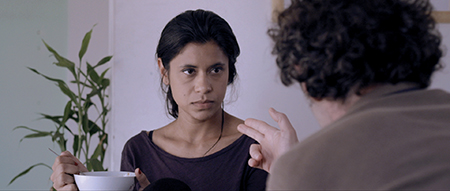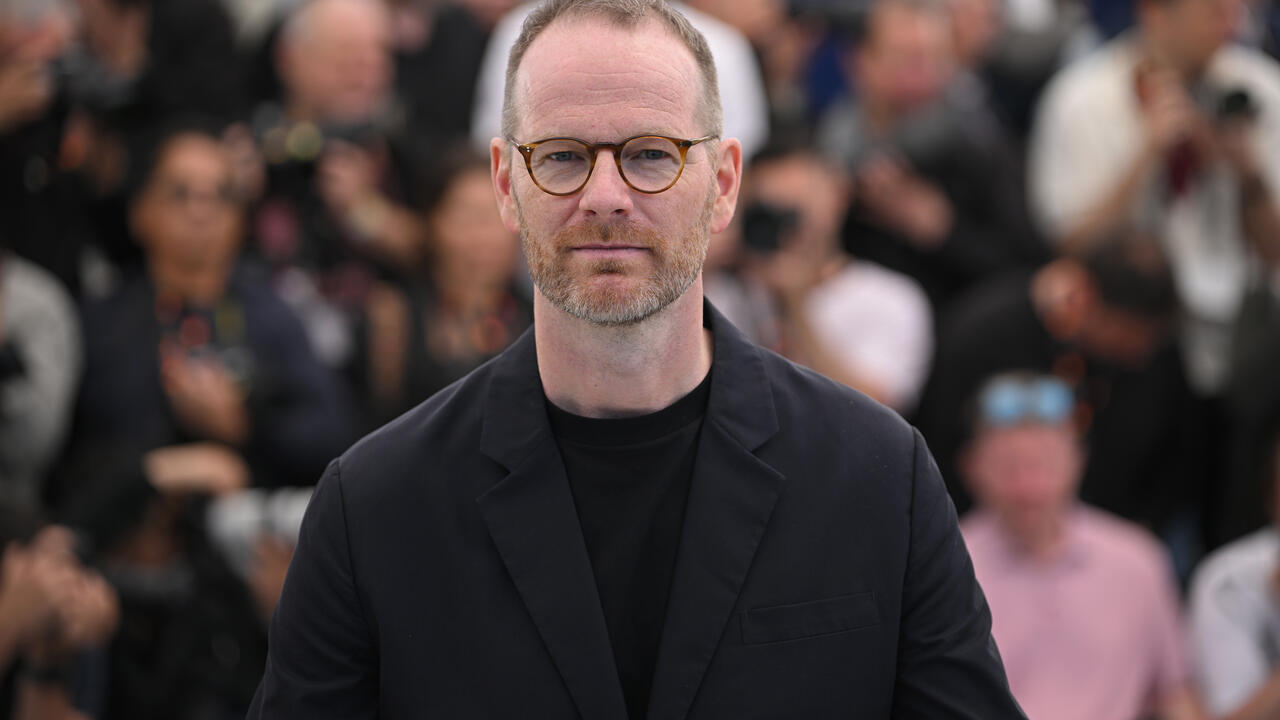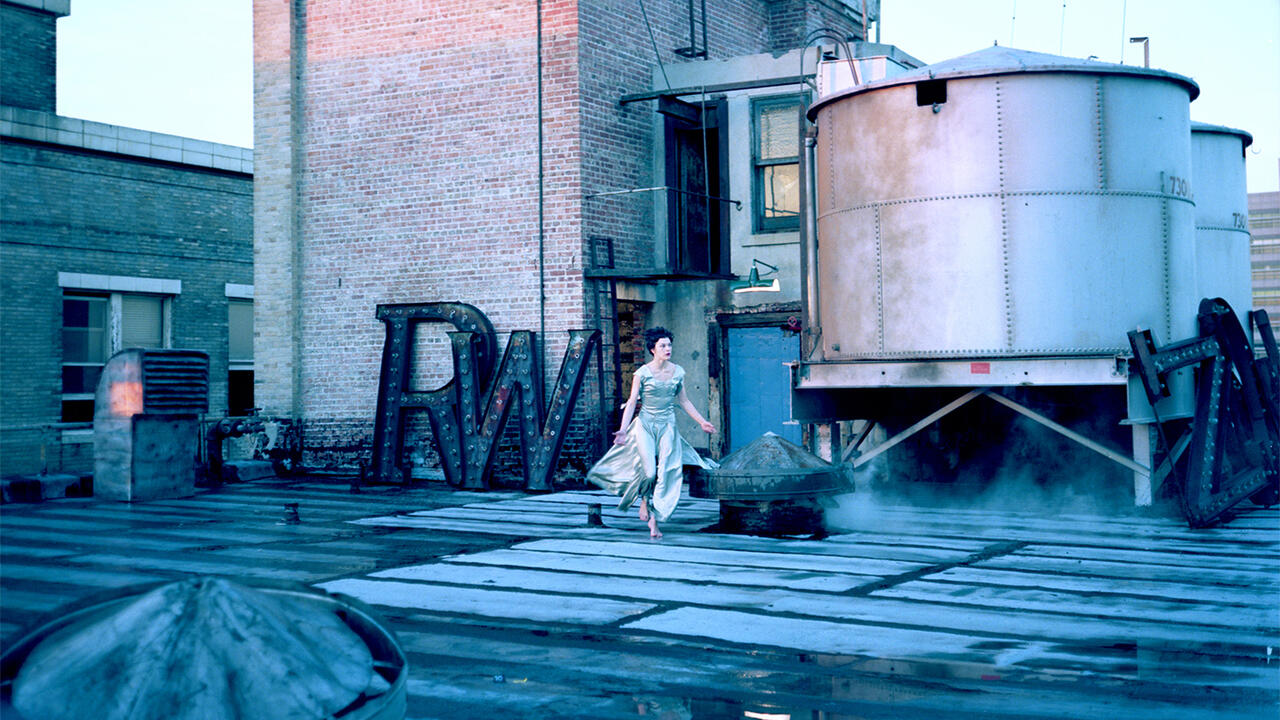Changed States
Collaboration and conflict in the work of Eric Baudelaire
Collaboration and conflict in the work of Eric Baudelaire

‘I was going to leave Lebanon, without being there officially,’ says the voice of May Shigenobu over Super-8 footage of Beirut and Tokyo, clips of Japanese new wave movies and shots of a TV screening current-affairs programmes. Grainy images taken from a moving vehicle bumps along, meeting tranquil panoramic shots of mountains and sobering views of the aftermath of bombings. This mix of imagery in Eric Baudelaire’s 2011 film The Anabasis of May and Fusako Shigenobu, Masao Adachi and 27 Years Without Images is typical of the Paris-based artist’s work.
An anabasis is a journey into the unknown followed by a return home, in a changed state. It’s a concept that relates to each of the titular characters in Baudelaire’s film, while also describing the artist’s approach to filmmaking. We learn that May’s mother named her in commemoration of the May 1972 Japanese Red Army (JRA) killings at Lod Airport in Tel Aviv, which saw 27 people lose their lives in what was arguably the first suicide mission in modern Middle Eastern history. ‘May’ is also a homonym for the last syllable of kakumei, the Japanese word for revolution. In The Anabasis…, May tells of her clandestine childhood in Lebanon, where she was born in secret and shielded from her true identity until she was a teenager, for fear of reprisal for her parents’ revolutionary activities. The voice of Masao Adachi, the Japanese new wave film director and JRA ideologue who also lived undercover in Beirut, says that for ten years he acted as father to May, her real father having died in the Lod attack. We learn that Baudelaire shot this film of Beirut as part of a deal he made with Adachi: in return for helping the artist with his film, Adachi, who is grounded in Japan, requested footage of the city to use in his own next production.

On one level, Baudelaire and Adachi’s deal is a bargain between a filmmaker and a political extremist, but it also demonstrates Baudelaire’s willingness to contribute to Adachi’s creative process. In addition to the footage, Adachi has the pleasure of collaborating with an artist: ‘How do Eric’s images, and the feelings that created them, overlap with my own feelings? This is what brings me joy.’ He also seeks to assuage his nostalgia for the city in which he fought his revolution, charging Baudelaire to ‘find the ruin of street-fighting of the past’. May and Adachi candidly describe the troubling events surrounding their lives in Beirut. Baudelaire does not temper their statements with testimony from opposing camps, nor does he introduce sentimental music, as a traditional documentary might do. He lets them speak freely, even when what they say is contentious, as when Adachi asks: ‘Why should the monopoly of violence be on the side of the state?’ Baudelaire sets his images to their voices in an aleatory way: they rarely illustrate statements but, rather, give a sense of what it might be like to experience the world through this person’s eyes. In this way, his films depart from an impartial documentary attitude and operate on a more poetic register, offering convincing access to the psyches and subjectivities of the individuals in question. In one regard, however, Baudelaire’s collaboration with Adachi does allude to a core aspect of documentary filmmaking: that is, its transactional nature, in which a subject’s life story is exchanged for money, fame or other desired benefits. In this case, the prize is the otherwise unobtainable footage of Beirut and the feelings it engenders in Adachi.
Baudelaire originally trained as a political scientist, but abandoned this to pursue photography and, eventually, filmmaking. All three disciplines share a concern with exploring the territory between narrative and reality. He often quotes Robert Filliou’s maxim: ‘Art is what makes life more interesting than art,’ and his work performs the interplay between the two. His most recent film, Letters to Max (2014), is a languid portrait of Max Gvinjia, Abkhazia’s former Minister of Foreign Affairs (and, for Baudelaire’s exhibitions of the work, its ‘Anambassador’). The artist first met Gvinjia in 2000, when he visited Abkhazia on a research trip. At the time, the Minister was just 24 years old. In the feature-length Letters to Max, Gvinjia’s voice-over gives an account of the difficult birth of Abkhazia, a secessionary area which split from Georgia in 1992 and has since been subject to civil war and disputed sovereignty. The film evolved out of a correspondence that started when Baudelaire sent Gvinjia a letter from Paris, an act of faith because France does not officially recognize Abkhazia. Somehow, Gvinjia got the letter and a correspondence ensued. The Minister recorded his responses and sent them via WeTransfer, which later formed the voice-over to images of Abkhazia that Baudelaire shot in 2013.

At one point in the film, the camera fixes on a tourist T-shirt bearing the slogan ‘Abkhazia: Country of the Future’. Baudelaire’s project highlights the imaginary and fictional qualities of geopolitics – and of film. A self-reflexive letter from Baudelaire probes the constructed nature of this collaborative work: ‘Are we making a film that goes backwards in time? […] Are we making a film about the future?’ We hear Gvinjia’s relaxed voice joking that their epistolary conversation is reminiscent of therapy sessions. His melancholy musings mix personal reminiscences with poetic observations and Gvinjia emerges as an atypical politician wracked by doubt, sentiment and humility. Watching it, I wanted Gvinjia to define his position on the topics at hand, but his phlegmatic personality seems to make this impossible. Baudelaire’s footage takes us to Gvinjia’s home and his former workplace; it shows us his family and friends as well as parts of the country he helped create. The vulnerability of each of these elements colours the story and our perception of Gvinjia: he no longer has his job; he has separated from his wife; and his country is under constant threat from its neighbour, Georgia. It’s hard to imagine Gvinjia ever returning to politics, or even how this young man, whose idealism borders on romanticism, was ever taken seriously in the bellicose milieu of Abkhazian politics.
Baudelaire screens his films at festivals, or in exhibitions where they are installed alongside photography, sculpture or text. In early 2014, he showed ‘The Secession Sessions’ simultaneously at Bétonsalon in Paris and at Bergen Kunsthall. Letters to Max was complemented by an exhibition, a symposium with international participants from the fields of art, politics and film, and the ‘Abkhazian Anembassy’, at which Gvinjia himself held public visiting hours. The ‘Anembassy’ etymologically, is the ‘embassy without’; but it is also a reminder of Baudelaire’s commitment to exploring anabasis. Placed inside a rectangle marked on the floor with orange tape, Gvinjia’s desk faced three chairs for visitors and was flanked by anAbkhazian flag. The film was switched off during visiting hours. The only other item in the room was one of the letters Baudelaire sent to Gvinjia, its presence ostensibly a reminder of the genesis of the project – although, given that much of the exchange actually took place online, the letter felt like a gesture to the history of writing during wartime, conjuring up the spectre of Anne Frank’s diary or letters secreted out of prisons.
In this space, Gvinjia was his own boss, a relaxed diplomat engaging with his interlocutors on topics ranging from food to politics. During my appointment, we discussed nationalist foundation myths, debated Baudelaire’s work and drew maps of the Black Sea countries. Gvinjia told me that the rarefied context of the contemporary art gallery suited the film, saying: ‘The work is my own personal story. I don’t want it shown too much on the internet.’ He added: ‘It’s also propaganda, but I didn’t think about it like that [at the time].’

Baudelaire’s first feature film, The Ugly One (2013), is a fragmented love story interlaced with an elegy to Beirut. Starring Lebanese actor and performance artist Rabih Mroué, it is based on a story by Adachi, who transformed his recollections of the city into a fiction in which the central characters manifest the fragmentation wrought on memory by trauma and conflict. The finished version departs in many ways from Adachi’s script, abandoning the original title, Beyond Memory, as well as the more oneiric or graphically violent scenes in which bodies are blown apart by explosions. When The Ugly One is exhibited, Adachi’s script is pinned to a wall near the screen, so that visitors can see how the revolutionary fervour of Adachi’s written words have mellowed into the mournful tone of Baudelaire’s film.
Baudelaire’s divergence from Adachi’s script for The Ugly One and from his exact instructions of what to film in Beirut with The Anabasis … are instances of Adachi’s principle of collaboration rooted in disagreement or conflict. This idea is at the root of fûkeiron, the Japanese ‘theory of landscape’ that Adachi founded in the late 1960s. Adachi applied it only once, in his 1969 film AKA Serial Killer. Going against the grain of the humanist documentary tradition, fûkeiron held that, by turning the camera away from its subjects to instead feature the landscape surrounding them, a film would reveal the true power structures at play in people’s lives. In The Anabasis … and The Ugly One, Baudelaire tests fûkeiron by turning the theory on Adachi himself, filming his environs in Beirut and Tokyo to verify that he, too, is a product of his surroundings.
In The Ugly One, Adachi tells us: ‘If I have one regret, it’s that my generation led the next one to a dead end.’ Ultimately, by wrestling with the stories of those who participated in revolution or are marked by trauma or who, like May Shigenobu, look back on their lives with a sense of bemusement, Baudelaire gives the lie to this lament, proving that Adachi’s principle of creative conflict is alive and well.






















